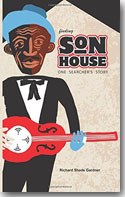|
Son House
Finding Son House: One
Searcher’s Story (book)
CreateSpace Indpendent
Publishing Platform |

Son House is
enjoying a nice resurgence in popularity and
appreciation these days and deservedly so. In late
August, the town of Rochester, New York, where House
lived for nearly a quarter century held a four-day
blues event honoring the Delta Blues legend during
which a Mississippi Blues Trail marker was unveiled
there in his honor. For the uninitiated, House is
one of the most influential of the early blues
artists, inspiring the music of icons like Robert
Johnson and Muddy Waters and therefore many of their
disciples, as well as setting the groundwork for
what is now known as the Chicago Blues.
His own story --- the
historical ’30s recordings for Paramount, his
seminal Library of Congress recordings, his
disappearance from the scene and “rediscovery” in
the ’60s, and his lifelong inner struggle between
the church and the world --- has been well covered
over the past few years. However, one phase of his
life --- the period between his second fade-out from
the blues scene in the mid ’70s until his death in
1988 --- has really not been as extensively covered.
Richard Shade Gardner
is a blues enthusiast who hosted his own blues radio
show in Rochester and became interested in House in
the early ’80s. He became determined to track down
and meet the great blues man. Gardner recounts this
quest in the book Finding Son House: One
Searcher’s Story, a brief, but engaging story
that neatly fills in the gap in information on
House’s last few years.
Gardner’s efforts
will surely strike home with most blues fans that
have wanted to and ended up having the opportunity
to meet one of their musical idols. I won’t reveal
any details about his journey and the aftermath,
only to say that it makes for compelling reading and
blues fans will devour this story easily in one
sitting, as I did. It’s both interesting and
entertaining.
Gardner also includes
several appendices which include a discography of
House’s recordings and some information on early
recordings by the Beatles and Rolling Stones listing
their covers of songs by earlier R&B and blues
artists.
The influence of Son
House on the blues and rock & roll can never be
overstated. In his foreword, Gardner says that if
the evolution of rock music was to be placed on an
organizational chart Son House would be the CEO, as
he bridged the gap between the musicians in the days
before recordings and radio who came before and
influenced him and the artists such as Johnson and
Waters, who directly followed him. Gardner’s book is
a nice tribute to this musical pioneer.
---
Graham Clarke
Read
Graham's blog